Light-Induced Colour Changes in Wood Surfaces in Indoor Conditions Determined by an Artificial Accelerated Test: Influence of Wood Species and Coating Materials
Abstract
:1. Introduction
2. Materials and Methods
2.1. Wooden Material
2.2. Coating Materials
2.3. Test Sample Preparation
2.4. Colour Measurements
2.5. Accelerated UV–VIS Light-Induced Ageing Procedure
2.6. Data Processing and Statistical Analysis
3. Results and Discussion
3.1. Light-Induced Colour Changes in the Uncoated Wood Surfaces
3.2. Light-Induced Colour Changes in the Coated Wood Surfaces
3.3. Light-Induced Colour Changes in the Wood Substrate under the Coating Film, Simulated by V1/Z1 Zones—Contribution of the Underlying Wood Substrate to Overall Colour Changes
3.4. Light-Induced Colour Changes in the Coating Films—Contribution of Finishing Film to the Overall Colour Changes
3.5. Influence of Wood Species and Coating Materials on the Light-Induced Colour Changes in Wood Surfaces
4. Conclusions
Author Contributions
Funding
Institutional Review Board Statement
Informed Consent Statement
Data Availability Statement
Acknowledgments
Conflicts of Interest
References
- Oltean, L.; Teischinger, A.; Hansmann, C. Wood surface discolouration due to simulated indoor sunlight exposure. Holz Als Roh-Und Werkst. 2007, 66, 51–56. [Google Scholar] [CrossRef]
- Kropat, M.; Hubbe, M.A.; Laleicke, F. Natural, Accelerated, and Simulated Weathering of Wodd: A Review. Bioresources 2020, 15, 9998–10062. [Google Scholar] [CrossRef]
- Spear, M.J.; Curling, S.F.; Dimitriou, A.; Ormondroyd, G.A. Review of Functional Treatments for Modified Wood. Coatings 2021, 11, 327. [Google Scholar] [CrossRef]
- Rajkovic, J.V.; Miklecic, J. Enhancing Weathering Resistance of Wood—A Review. Polymers 2021, 13, 1980. [Google Scholar] [CrossRef]
- Blanchet, P.; Pepin, S. Trends in Chemical Wood Surface Improvements and Modifications: A Review of the Last Five Years. Coatings 2021, 11, 1514. [Google Scholar] [CrossRef]
- Yi, T.; Morrell, J.J. Role of α/γ Fe2O3 and ZnO nano-particles in reducing photodegradation of wood components. Wood Sci. Technol. 2023, 57, 427–446. [Google Scholar] [CrossRef]
- Lee, H.-W.; Lee, E.-J.; Shin, Y.-J.; Jo, H.-Y.; Song, D.-Y. Surface Discoloration of Ultraviolet (UV)-Irradiated Phyllostachys bambusoides Bamboo. J. Korean Wood Sci. Technol. 2023, 51, 173–182. [Google Scholar] [CrossRef]
- Fengel, D.W.G.; de Gruyter, W. Wood—Chemistry, Ultrastructure, Reactions; Gruyter, W.D., Ed.; Walter de Gruyter: Berlin, Germany; New York, NY, USA, 1985. [Google Scholar] [CrossRef]
- Müller, U.; Rätzsch, M.; Schwanninger, M.; Steiner, M.; Zöbl, H. Yellowing and IR-changes of spruce wood as result of UV-irradiation. J. Photochem. Photobiol. B Biol. 2003, 69, 97–105. [Google Scholar] [CrossRef]
- George, B.; Suttie, E.; Merlin, A.; Deglise, X. Photodegradation and photostabilisation of wood—The state of the art. Polym. Degrad. Stab. 2005, 88, 268–274. [Google Scholar] [CrossRef]
- Williams, R.S. Weathering of Wood. In Handbook of Wood Chemistry and Wood Composites; USDA, Forest Service, Forest Products Laboratory: Madison, WI, USA, 2005. Available online: https://www.fs.usda.gov/research/treesearch/22122 (accessed on 8 September 2023).
- Evans, P.; Chowdhury, M.; Mathews, B.; Schmalzl, K.; Ayer, S.; Kiguchi, M.; Kataoka, Y. Weathering and Surface Protection of Wood. In Handbook of Environmental Degradation of Materials; William Andrew Inc.: New York, NY, USA, 2005; pp. 277–297. [Google Scholar] [CrossRef]
- Teacă, C.A.; Roşu, D.; Bodîrlău, R.; Roşu, L. Structural Changes in Wood under Artificial UV Light Irradiation Determined by FTIR Spectroscopy and Color Measurements—A Brief Review. BioResources 2013, 8, 1478–1507. [Google Scholar] [CrossRef]
- Kataoka, Y.; Kiguchi, M.; Williams, R.S.; Evans, P.D. Violet light causes photodegradation of wood beyond the zone affected by ultraviolet radiation. Holzforschung 2007, 61, 23–27. [Google Scholar] [CrossRef]
- Živković, V.; Arnold, M.; Radmanović, K.; Richter, K.; Turkulin, H. Spectral sensitivity in the photodegradation of fir wood (Abies alba Mill.) surfaces: Colour changes in natural weathering. Wood Sci. Technol. 2014, 48, 239–252. [Google Scholar] [CrossRef]
- Agresti, G.; Bonifazi, G.; Calienno, L.; Capobianco, G.; Lo Monaco, A.; Pelosi, C.; Picchio, R.; Serranti, S. Surface Investigation of Photo-Degraded Wood by Colour Monitoring, Infrared Spectroscopy, and Hyperspectral Imaging. J. Spectrosc. 2013, 2013, 380536. [Google Scholar] [CrossRef]
- Zahri, S.; Belloncle, C.; Charrier, F.; Pardon, P.; Quideau, S.; Charrier, B. UV light impact on ellagitannins and wood surface colour of European oak (Quercus petraea and Quercus robur). Appl. Surf. Sci. 2007, 253, 4985–4989. [Google Scholar] [CrossRef]
- Chang, T.-C.; Chang, H.-T.; Wu, C.-L.; Chang, S.-T. Influences of extractives on the photodegradation of wood. Polym. Degrad. Stab. 2010, 95, 516–521. [Google Scholar] [CrossRef]
- Chang, T.-C.; Chang, H.-T.; Wu, C.-L.; Lin, H.-Y.; Chang, S.-T. Stabilizing effect of extractives on the photo-oxidation of Acacia confusa wood. Polym. Degrad. Stab. 2010, 95, 1518–1522. [Google Scholar] [CrossRef]
- Chang, T.-C.; Lin, H.-Y.; Wang, S.-Y.; Chang, S.-T. Study on inhibition mechanisms of light-induced wood radicals by Acacia confusa heartwood extracts. Polym. Degrad. Stab. 2014, 105, 42–47. [Google Scholar] [CrossRef]
- Passauer, L.; Prieto, J.; Müller, M.; Rössler, M.; Schubert, J.; Beyer, M. Novel color stabilization concepts for decorative surfaces of native dark wood and thermally modified timber. Prog. Org. Coat. 2015, 89, 314–322. [Google Scholar] [CrossRef]
- Oltean, L.; Hansmann, C.; Németh, R.; Teischinger, A. Wood surface discolouration of three hungarian hardwood species due to simulated indoor sunlight exposure. Wood Res. 2010, 55, 49–58. Available online: https://www.researchgate.net/publication/299019578 (accessed on 11 October 2023).
- Timar, M.C.; Varodi, A.M.; Gurău, L. Comparative study of photodegradation of six wood species after short-time UV exposure. Wood Sci. Technol. 2016, 50, 135–163. [Google Scholar] [CrossRef]
- Liu, X.Y. Contributions to the Study of Ageing Phenomena of Wooden Substrate and Traditional Materials for Transparent Finishes—A Comparative Approach for Europe and China with Applicability in Furniture Conservation/Restoration. Ph.D. Thesis, Transilvania University, Brasov, Romania, 2017. [Google Scholar]
- Liu, R.; Zhu, H.; Li, K.; Yang, Z. Comparison on the Aging of Woods Exposed to Natural Sunlight and Artificial Xenon Light. Polymers 2019, 11, 709. [Google Scholar] [CrossRef] [PubMed]
- Cirule, D.; Kuka, E.; Sansonetti, E.; Hivrica, M.; Andersone, I.; Andersons, B. Wood photosensitivity to different artificial light sources. Eur. J. Wood Wood Prod. 2022, 80, 1507–1519. [Google Scholar] [CrossRef]
- Cirule, D.; Kuka, E.; Andersone, I.; Andersons, B. Wood discoloration patterns depending on the light source. Herit. Sci. 2022, 10, 158. [Google Scholar] [CrossRef]
- MacLeod, I.T.; Scully, A.D.; Ghiggino, K.P.; Ritchie, P.J.A.; Paravagna, O.M.; Leary, B. Photodegradation at the wood-clearcoat interface. Wood Sci. Technol. 1995, 29, 183–189. [Google Scholar] [CrossRef]
- Forsthuber, B.; Müller, U.; Teischinger, A.; Grüll, G. Chemical and mechanical changes during photooxidation of an acrylic clear wood coat and its prevention using UV absorber and micronized TiO2. Polym. Degrad. Stab. 2013, 98, 1329–1338. [Google Scholar] [CrossRef]
- Saha, S.; Kocaefe, D.; Boluk, Y.; Pichette, A. Surface degradation of CeO2 stabilized acrylic polyurethane coated thermally treated jack pine during accelerated weathering. Appl. Surf. Sci. 2013, 276, 86–94. [Google Scholar] [CrossRef]
- Aloui, F.; Ahajji, A.; Irmouli, Y.; George, B.; Charrier, B.; Merlin, A. Inorganic UV absorbers for the photostabilisation of wood-clearcoating systems: Comparison with organic UV absorbers. Appl. Surf. Sci. 2007, 253, 3737–3745. [Google Scholar] [CrossRef]
- Ncube, E.; Meincken, M. Surface characteristics of coated soft- and hardwoods due to UV-B ageing. Appl. Surf. Sci. 2010, 256, 7504–7509. [Google Scholar] [CrossRef]
- Rao, F.; Chen, Y.; Zhao, X.; Cai, H.; Li, N.; Bao, Y. Enhancement of bamboo surface photostability by application of clear coatings containing a combination of organic/inorganic UV absorbers. Prog. Org. Coat. 2018, 124, 314–320. [Google Scholar] [CrossRef]
- Esposito, C.C.; Frigione, M. Novel UV-Cured Nanocomposite Used for the Protection of Walnut Wood Artworks. Wood Res. 2014, 59, 229–244. Available online: https://www.researchgate.net/publication/287350116_Novel_UV-cured_nanocomposite_used_for_the_protection_of_walnut_wood_artworks (accessed on 22 October 2023).
- Chou, P.L.; Chang, H.T.; Yeh, T.F.; Chang, S.T. Characterizing the conservation effect of clear coatings on photodegradation of wood. Bioresour. Technol. 2008, 99, 1073–1079. [Google Scholar] [CrossRef]
- Capobianco, G.; Calienno, L.; Pelosi, C.; Scacchi, M.; Bonifazi, G.; Agresti, G.; Picchio, R.; Santamaria, U.; Serranti, S.; Monaco, A.L. Protective behaviour monitoring on wood photo-degradation by spectroscopic techniques coupled with chemometrics. Spectrochim. Acta Part A Mol. Biomol. Spectrosc. 2017, 172, 34–42. [Google Scholar] [CrossRef]
- Mahltig, B.; Swaboda, C.; Roessler, A.; Böttcher, H. Functionalising wood by nanosol application. J. Mater. Chem. 2008, 18, 3180–3192. [Google Scholar] [CrossRef]
- Wu, X.; Yang, F.; Gan, J.; Kong, Z.; Wu, Y. A Superhydrophobic, Antibacterial, and Durable Surface of Poplar Wood. Nanomaterials 2021, 11, 1885. [Google Scholar] [CrossRef]
- Panek, M.; Oberhofnerova, E.; Hysek, S.; Sedivka, P.; Zeidler, A. Colour Stabilization of Oak, Spruce, Larch and Douglas Fir Heartwood Treated with Mixtures of Nanoparticle Dispersions and UV-Stabilizers after Exposure to UV and VIS-Radiation. Materials 2018, 11, 1653. [Google Scholar] [CrossRef]
- Olsson, S.K.; Johansson, M.; Westin, M.; Östmark, E. Reactive UV-absorber and epoxy functionalized soybean oil for enhanced UV-protection of clear coated wood. Polym. Degrad. Stab. 2014, 110, 405–414. [Google Scholar] [CrossRef]
- Bielerman, J. Lackadditive; Wiley-VCH: Weinheim, Germany; New York, NY, USA; Chichester, UK; Brisbane, Australia; Singapore; Toronto, ON, Canada, 1998; p. 395. Available online: https://epdf.tips/lackadditive-german-edition.html (accessed on 19 September 2023).
- Rosu, D.; Teaca, C.A.; Bodirlau, R.; Rosu, L. FTIR and color change of the modified wood as a result of artificial light irradiation. J. Photochem. Photobiol. B 2010, 99, 144–149. [Google Scholar] [CrossRef]
- Essoua, G.G.E.; Blanchet, P.; Landry, V.; Beauregard, R. Maleic Anhydride Treated Wood: Effects of Drying Timeand Esterification Temperature on Properties. BioResources 2015, 10, 6830–6860. [Google Scholar] [CrossRef]
- Dong, Y.; Yan, Y.; Ma, H.; Zhang, S.; Li, J.; Xia, C.; Shi, S.Q.; Cai, L. In-Situ Chemosynthesis of ZnO Nanoparticles to Endow Wood with Antibacterial and UV-Resistance Properties. J. Mater. Sci. Technol. 2017, 33, 266–270. [Google Scholar] [CrossRef]
- Yuan, B.; Guo, M.; Huang, Z.; Naik, N.; Hu, Q.; Guo, Z. A UV-shielding and hydrophobic graphitic carbon nitride nanosheets/cellulose nanofibril (gCNNS/CNF) transparent coating on wood surface for weathering resistance. Prog. Org. Coat. 2021, 159, 106440. [Google Scholar] [CrossRef]
- Torcătoru, M.-J.; Timar, C.M. An experimental method to evaluate the contribution of the wood substrate and of the coating film in the global light in-duced colour changes of wood surfaces in indoors conditions. Bull. Transilv. Univ. Bras. Ser. II For.-Wood Ind.-Agric. Wood Eng. 2023, 16, 205–226. [Google Scholar] [CrossRef]
- Deka, M.; Petric, M. Photo-degradation of water borne acrylic coated modified and non-modified wood during artificial light exposure. BioResources 2008, 3, 346–362. [Google Scholar] [CrossRef]
- Liu, X.Y.; Timar, M.C.; Varodi, A.; Nedelcu, R.; Torcătoru, M.-J. Colour and Surface Chemistry Changes of Wood Surfaces Coated with Two Types of Waxes after Seven Years Exposure to Natural Light in Indoor Conditions. Coatings 2022, 12, 1689. [Google Scholar] [CrossRef]
- Available online: https://www.renneritalia.com/en/ (accessed on 13 October 2023).
- Available online: http://www.kroncolor.ro/contact.html (accessed on 18 October 2023).
- Available online: https://www.avantes.com/ (accessed on 27 October 2023).
- ISO-4582-2017; Plastics—Determination of Changes in Colour and Variations in Properties after Exposure to Glass-Filtered Solar Radiation, Natural Weathering or Laboratory Radiation Sources-Requirements. ISO: Geneva, Switzerland, 2017.
- Timar, M.C.; Beldean, E.C. Modification of Shellac with Clove (Eugenia caryophyllata) and Thyme (Satureja hortensis) Essential Oils: Compatibility Issues and Effect on the UV Light Resistance of Wood Coated Surfaces. Coatings 2022, 12, 1591. [Google Scholar] [CrossRef]
- ISO 16474-3:2013; Paints and Varnishes—Methods of Exposure to Laboratory Light Sources Part 3: Fluorescent UV Lamps. ISO: Geneva, Switzerland, 2013.
- Persze, L.; Tolvaj, L. Photodegradation of wood at elevated temperature: Colour change. J. Photochem. Photobiol. B Biol. 2012, 108, 44–47. [Google Scholar] [CrossRef]
- Duarte, I.; Rotter, A.; Malvestiti, A.; Silva, M. The role of glass as a barrier against the transmission of ultraviolet radiation: An experimental study. Photodermatol. Photoimmunol. Photomed. 2009, 25, 181–184. [Google Scholar] [CrossRef]
- Serrano, M.A.; Moreno, J.C. Spectral transmission of solar radiation by plastic and glass materials. J. Photochem. Photobiol. B 2020, 208, 111894. [Google Scholar] [CrossRef]
- Dawson, B.S.W.; Singh, A.P.; Kroese, H.W.; Schwitzer, M.A.; Gallagher, S.; Riddiough, S.J.; Wu, S. Enhancing exterior performance of clear coatings through photostabilization of wood. Part 2: Coating and weathering performance. J. Coat. Technol. Res. 2008, 5, 207–219. [Google Scholar] [CrossRef]
- Kúdela, J.; Sikora, A.; Gondáš, L. Wood Surface Finishing with Transparent Lacquers Intended for Indoor Use, and the Colour Resistance of These Surfaces during Accelerated Aging. Polymers 2023, 15, 747. [Google Scholar] [CrossRef]
- Meijer, D.M. A Review of Interfacial Aspects in Wood Coatings: Wetting, Surface Energy, Substrate Penetration and Adhesion; 2005. In Proceedings of the COST E18 FInal Seminar, Paris, France, 26–27 May 2005; Available online: https://www.researchgate.net/publication/260601859_A_review_of_interfacial_aspects_in_wood_coatings_wetting_surface_energy_substrate_penetration_and_adhesion (accessed on 7 December 2023).
- Meijer, D.M.; Thurich, K.; Militz, H. Comparative study on penetration characteristics of modern wood coatings. Wood Sci. Technol. 1998, 32, 347–365. [Google Scholar] [CrossRef]
- Meijer, D.M.; Thurich, K.; Militz, H. Quantitative measurements of capillary coating penetration in relation to wood and coating properties. Holz Als Roh-Und Werkst. 2001, 59, 35–45. [Google Scholar] [CrossRef]
- Özgenç, K.Ö.; Hiziroglu, S.; Yildiz, U. Weathering properties of wood species treated with different coating applications. BioResources 2012, 7, 4875–4888. [Google Scholar] [CrossRef]
- Kanbayashi, T.; Matsunaga, M.; Kobayashi, M.; Maeda, K. Elucidation of the degradative behavior of coated-wood surfaces exposed to artificial weathering using Raman microspectroscopy. Prog. Org. Coat. 2024, 187, 108184. [Google Scholar] [CrossRef]
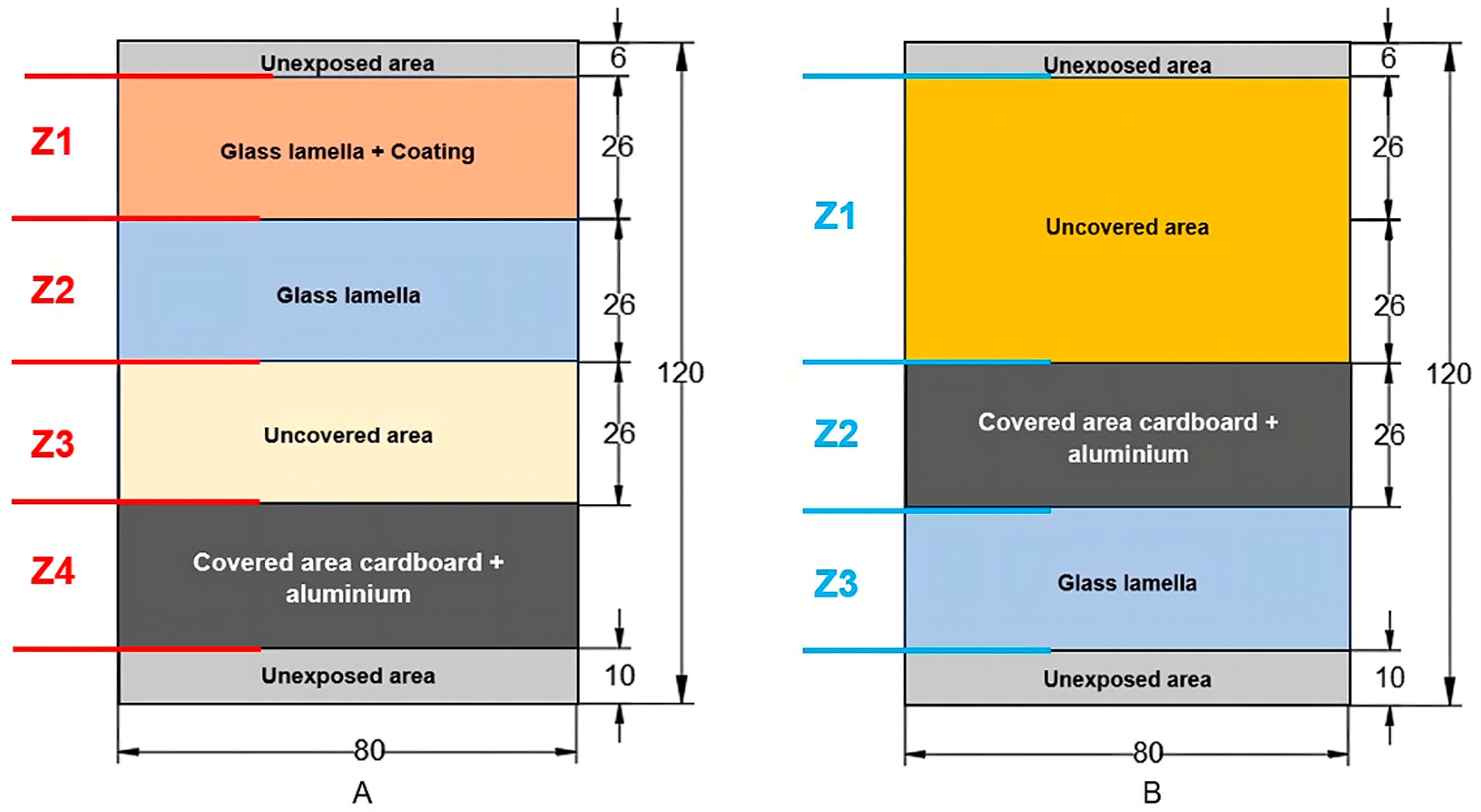
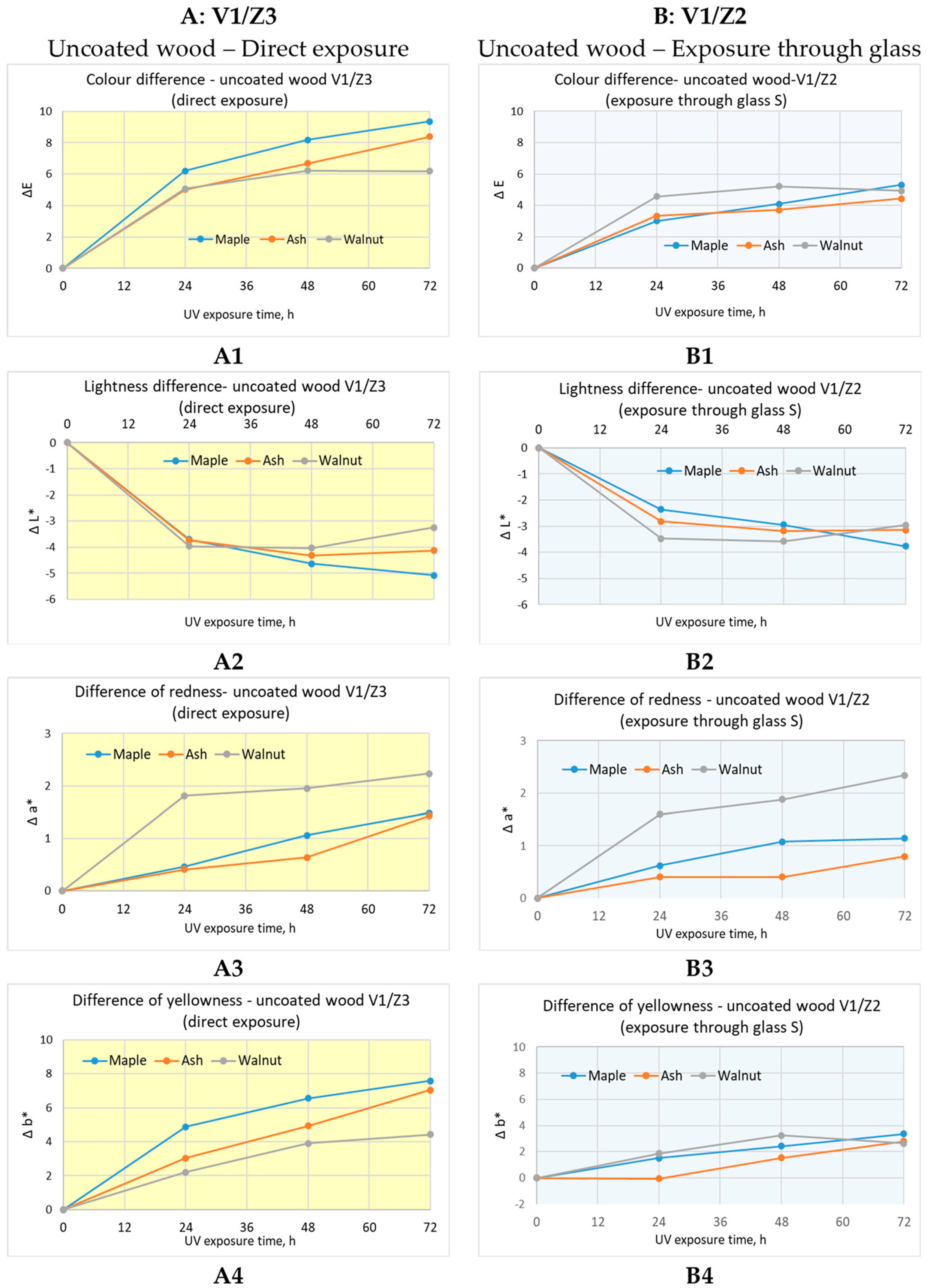
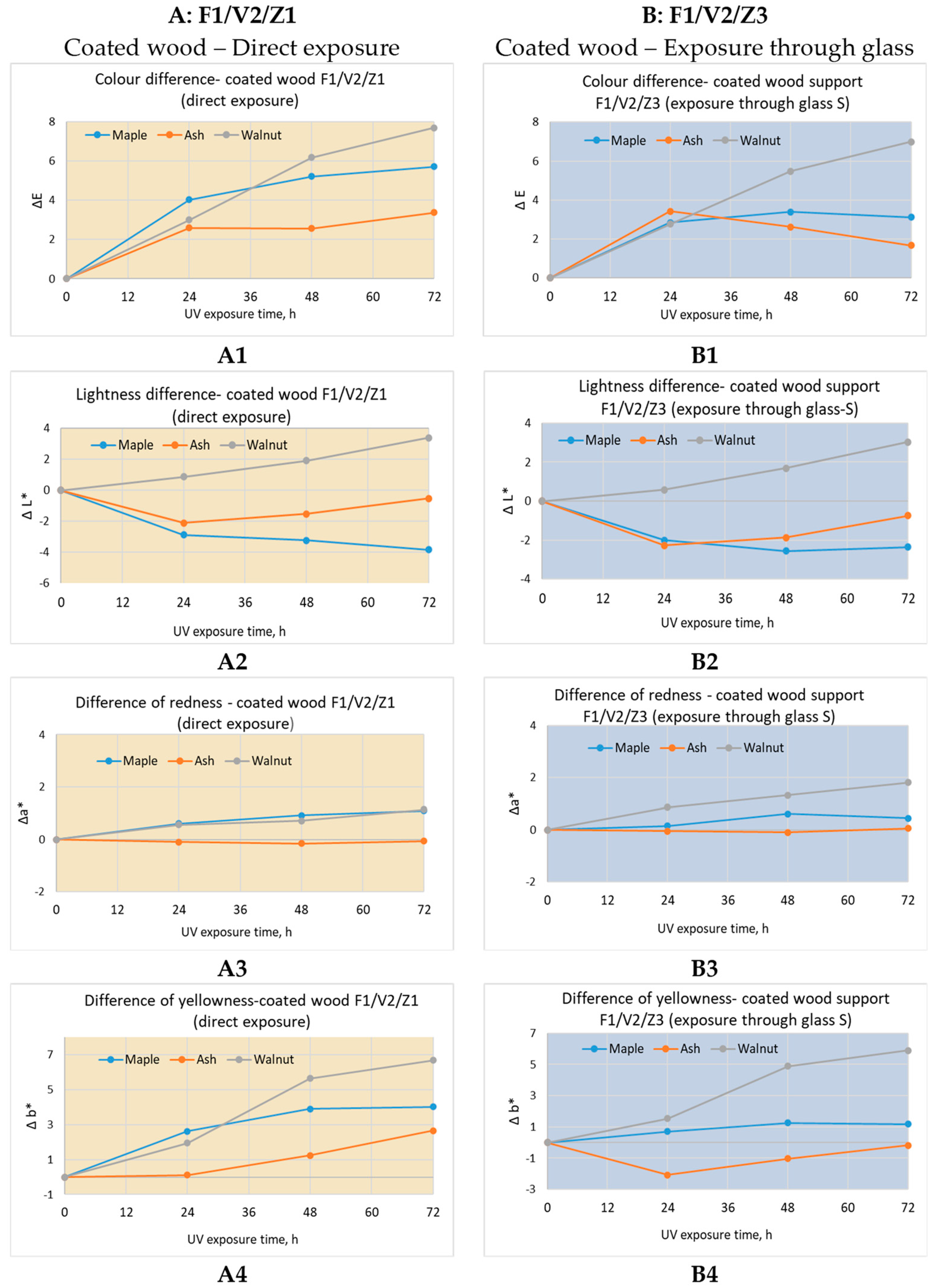
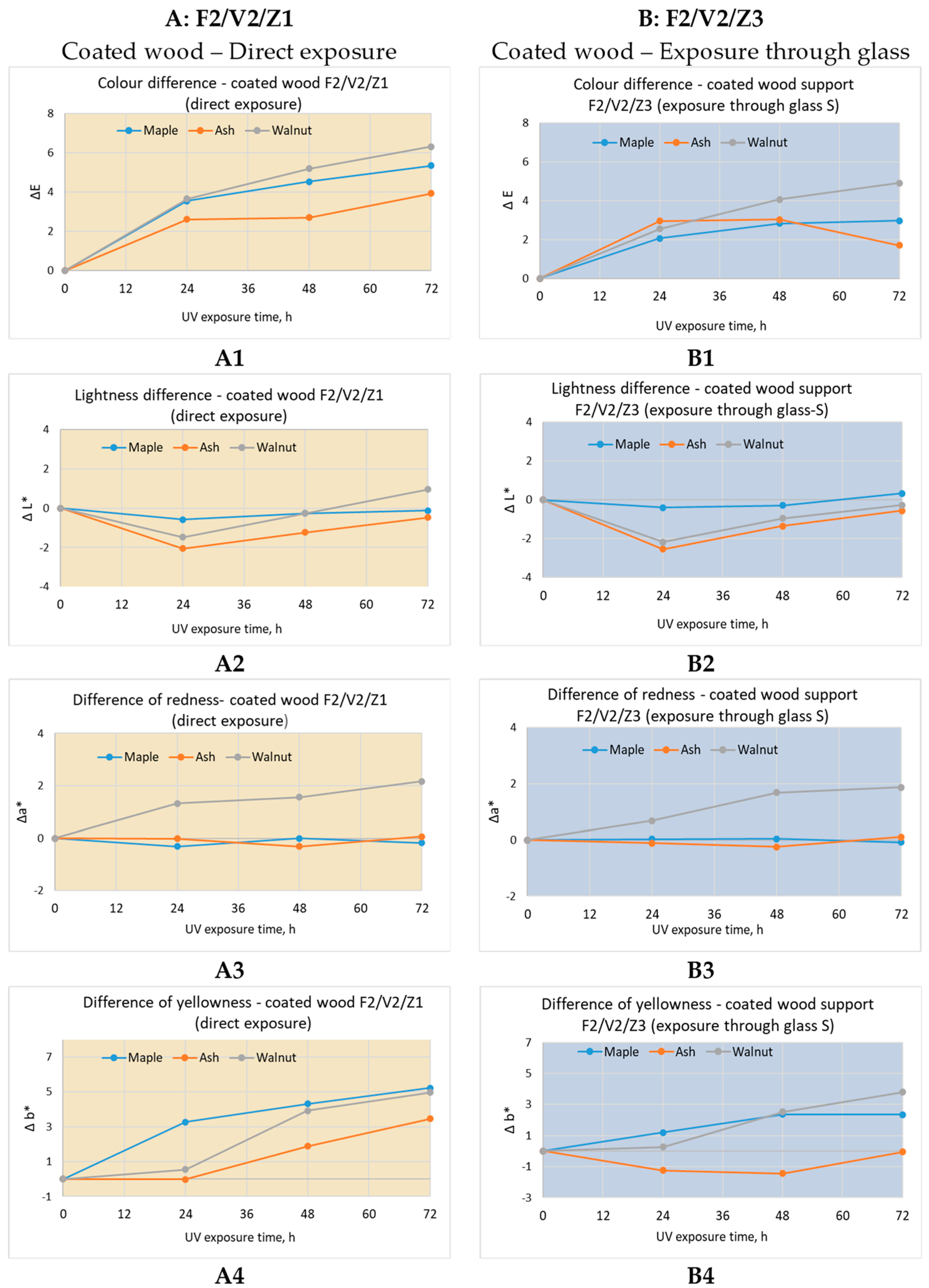

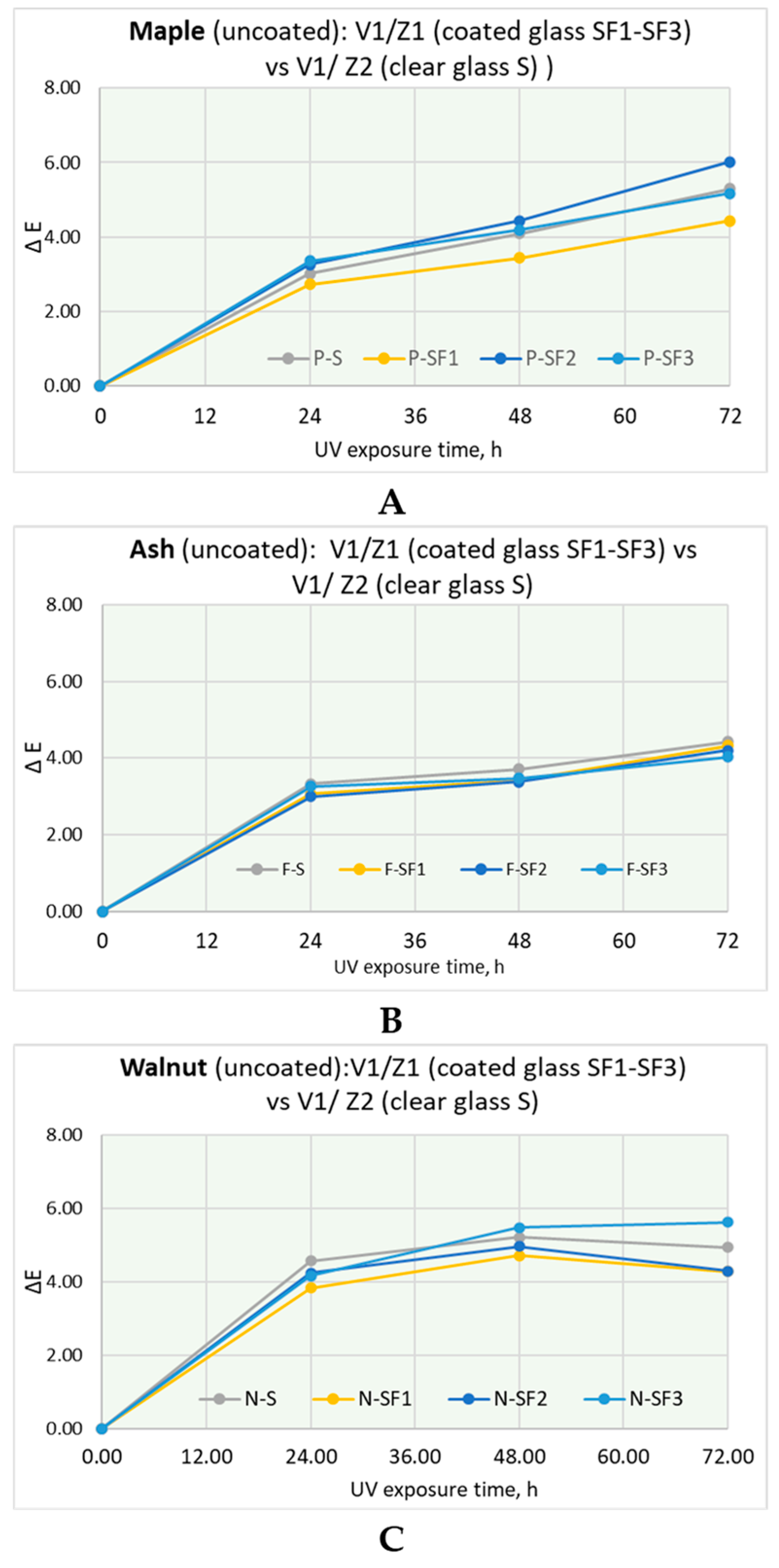

| Lb. Code | Commercial Code | Film-Forming Resin | Solids Content, Csu, % | Density, g/cm3 | Formulation | Gardner Gloss Index |
|---|---|---|---|---|---|---|
| F1 | YO 20-M702 | Acrylic-polyurethane (non-yellowing) | 25 ± 1 | 1.02 | 1k | 20 |
| F2 | YO 15-M864 | Acrylic (non-yellowing) | 34 ± 1 | 1.03 | 1k | 15 |
| F3 | YO 20-M838 | Polyurethane | 30 ± 1 | 1.03 | 1k | 20 |
| Wood Species Substrate | Experimental/Calculated Value | Type of Coating | ||
|---|---|---|---|---|
| F1 | F2 | F3 | ||
| Maple | Application rate [g/m2] | 191.1 ± 16.2 | 196.3 ± 19.7 | 203.5 ± 20.2 |
| Film thickness [μm] | 47.8 | 57.9 | 55.6 | |
| Ash | Application rate [g/m2] | 180.5 ± 25.8 | 203.3 ± 17.4 | 168.3 ± 4.0 |
| Film thickness [μm] | 45.1 | 59.9 | 46.0 | |
| Walnut | Application rate [g/m2] | 161.6 ± 16.2 | 184.9 ± 28.6 | 189.4 ± 17.4 |
| Film thickness [μm] | 40.4 | 54.5 | 51.8 | |
| Glass lamella | Film thickness [mm] | 0.034 ± 0.004 | 0.043 ± 0.008 | 0.046 ± 0.007 |
| Coating material | Solids content [%] | 25.0 | 29.5 | 27.3 |
| Flow time, ϕ 6 mm, 20 °C [s] | 12 | 49 | 6 | |
| Wood Species | Colour Changes after 72 h Light /UV Exposure | ||||||
|---|---|---|---|---|---|---|---|
| V1/Z2 Uncoated Wood under Clear Glass (Reference Values) | V1/Z1 Uncoated Wood under Coated Glass | ||||||
| (F1) | (F2) | (F3) | F1 | F2 | F3 | ||
| Maple | ∆E | 4.90 (1.39) | 5.80 (1.13) | 5.20 (1.86) | 4.44 (1.36) | 6.02 (1.55) | 5.17 (1.73) |
| ∆L* | −3.56 (1.42) | −4.29 (0.62) | −3.43 (1.46) | −3.51 (1.11) | −4.37 (1.16) | −3.36 (1.85) | |
| ∆a* | 0.99 (0.52) | 1.74 (0.51) | 0.70 (0.68) | 1.00 (0.32) | 1.26 (0.71) | 0.45 (0.71) | |
| ∆b* | 2.95 (1.23) | 3.40 (1.16) | 3.69 (1.47) | 2.33 (1.24) | 3.82 (1.28) | 3.64 (1.15) | |
| Ash | ∆E | 4.84 (0.76) | 4.23 (0.82) | 4.23 (1.34) | 4.32 (1.15) | 4.20 (0.77) | 4.03 (0.96) |
| ∆L* | −3.25 (0.55) | −2.94 (0.76) | −3.23 (1.30) | −3.07 (1.11) | −3.16 (0.59) | −2.98 (1.39) | |
| ∆a* | 0.80 (0.32) | 0.67 (0.58) | 0.92 (0.65) | 0.79 (0.54) | 0.76 (0.27) | 0.50 (0.82) | |
| ∆b* | 3.45 (0.73) | 2.70 (1.18) | 2.22 (1.25) | 2.79 (0.88) | 2.62 (0.64) | 2.18 (0.94) | |
| Walnut | ∆E | 4.77 (1.38) | 4.51 (1.13) | 5.52 (1.52) | 4.51 (1.54) | 4.83 (1.35) | 5.93 (1.20) |
| ∆L* | −3.37 (1.88) | −2.07 (0.74) | −2.13 (1.43) | −3.18 (1.60) | −2.32 (0.79) | −2.22 (1.38) | |
| ∆a* | 2.26 (0.66) | 2.55 (1.10) | 2.51 (0.74) | 2.19 (0.61) | 2.08 (1.12) | 2.41 (0.72) | |
| ∆b* | 2.99 (1.03) | 2.99 (1.34) | 4.15 (1.55) | 1.83 (1.33) | 2.94 (2.35) | 4.56 (1.77) | |
| Anova: Two-Factor with Replication (α = 0.05) | ||||||
|---|---|---|---|---|---|---|
| Source of Variation | SS | df | MS | F | p-Value | F Crit |
| Wood species (1) | 44.95563 | 2 | 22.47781 | 12.13096 | 2.88142 × 10−5 | 3.123907 |
| Type of coating (2) | 13.78771 | 2 | 6.893853 | 3.720516 | 0.028997068 | 3.123907 |
| Interaction (1)x(2) | 18.01943 | 4 | 4.504858 | 2.431209 | 0.055229542 | 2.498919 |
| Within | 133.4109 | 72 | 1.852929 | |||
| Total | 210.1737 | 80 | ||||
| Wood Species | Colour Changes after 72 h Light /UV Exposure | ||||
|---|---|---|---|---|---|
| Uncoated V1/Z3 | F1 V2/Z1 | F2 V2/Z1 | F3 V2/Z1 | ||
| Maple | ∆E | 9.36 A (1.71) | 5.71 B (1.20) | 5.35 B (2.11) | 4.92 B (1.64) |
| ∆L* | −5.07 C (1.61) | −3.83 B (0.84) | −0.11 A (1.18) | −3.56 B (1.76) | |
| ∆a* | 1.48 B (0.79) | 1.09 B (0.58) | −0.14 C (0.66) | 2.60 A (1.45) | |
| ∆b* | 7.58 A (1.38) | 4.03 B (1.49) | 5.11 B (2.30) | −0.52 C (1.48) | |
| Ash | ∆E | 8.39 A (1.28) | 3.37 B (1.37) | 3.94 B (1.24) | 2.25 C (1.02) |
| ∆L* | −4.13 B (1.13) | −0.52 A (1.74) | −0.48 A (1.50) | −0.51 A (1.57) | |
| ∆a* | 1.43 A (0.46) | −0.06 B (0.93) | 0.06 B (0.86) | 0.49 B (0.97) | |
| ∆b* | 7.05 A (1.38) | 2.65 B (1.49) | 3.45 B (1.45) | 0.24 C (1.55) | |
| Walnut | ∆E | 6.20 B (1.34) | 7.70 A (1.91) | 6.31 AB (2.04) | 4.74 C (1.40) |
| ∆L* | −3.25 C (1.62) | 3.40 A (1.36) | 0.96 B (2.60) | 2.14 AB (1.15) | |
| ∆a* | 2.23 A (0.85) | 1.14 B (0.63) | 2.16 A (0.71) | 1.61 AB (1.02) | |
| ∆b* | 4.42 B (1.38) | 6.69 A (1.76) | 4.96 AB (2.67) | 3.24 B (2.16) | |
| Anova: Two-Factor with Replication (α = 0.05) | ||||||
|---|---|---|---|---|---|---|
| Source of Variation | SS | df | MS | F | p-Value | F Crit |
| Wood species (1) | 266.8111 | 2 | 133.4055 | 52.71715 | 3.83802 × 10−18 | 3.055162 |
| Type of coating (2) | 77.40668 | 2 | 38.70334 | 15.29419 | 8.80515 × 10−7 | 3.055162 |
| Interaction (1)x(2) | 33.53909 | 4 | 8.384773 | 3.313366 | 0.012333886 | 2.430772 |
| Within | 387.1804 | 153 | 2.530591 | |||
| Total | 764.9372 | 161 | ||||
Disclaimer/Publisher’s Note: The statements, opinions and data contained in all publications are solely those of the individual author(s) and contributor(s) and not of MDPI and/or the editor(s). MDPI and/or the editor(s) disclaim responsibility for any injury to people or property resulting from any ideas, methods, instructions or products referred to in the content. |
© 2024 by the authors. Licensee MDPI, Basel, Switzerland. This article is an open access article distributed under the terms and conditions of the Creative Commons Attribution (CC BY) license (https://creativecommons.org/licenses/by/4.0/).
Share and Cite
Torcătoru, M.-J.; Timar, M.C. Light-Induced Colour Changes in Wood Surfaces in Indoor Conditions Determined by an Artificial Accelerated Test: Influence of Wood Species and Coating Materials. Appl. Sci. 2024, 14, 1226. https://doi.org/10.3390/app14031226
Torcătoru M-J, Timar MC. Light-Induced Colour Changes in Wood Surfaces in Indoor Conditions Determined by an Artificial Accelerated Test: Influence of Wood Species and Coating Materials. Applied Sciences. 2024; 14(3):1226. https://doi.org/10.3390/app14031226
Chicago/Turabian StyleTorcătoru, Mihai-Junior, and Maria Cristina Timar. 2024. "Light-Induced Colour Changes in Wood Surfaces in Indoor Conditions Determined by an Artificial Accelerated Test: Influence of Wood Species and Coating Materials" Applied Sciences 14, no. 3: 1226. https://doi.org/10.3390/app14031226






